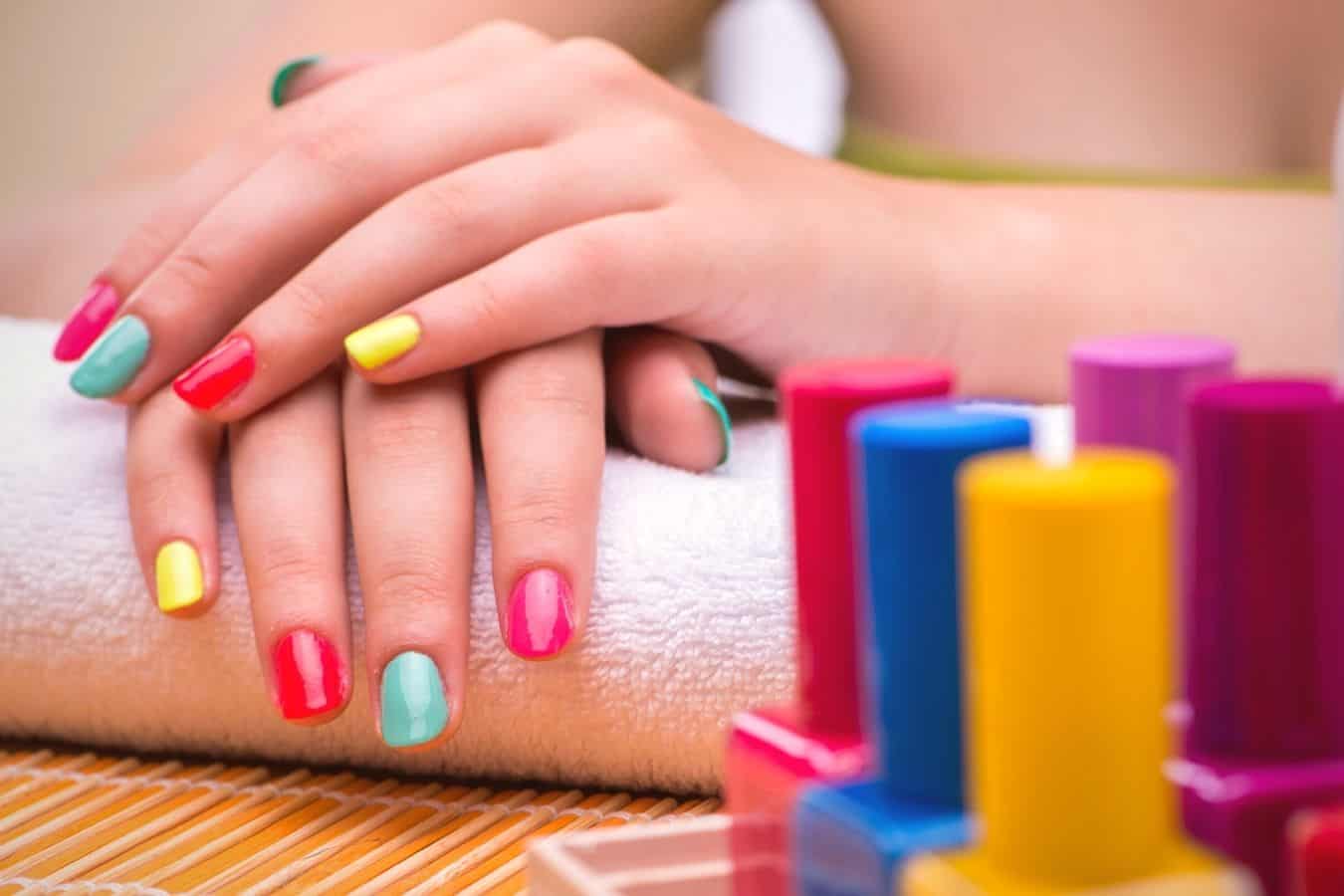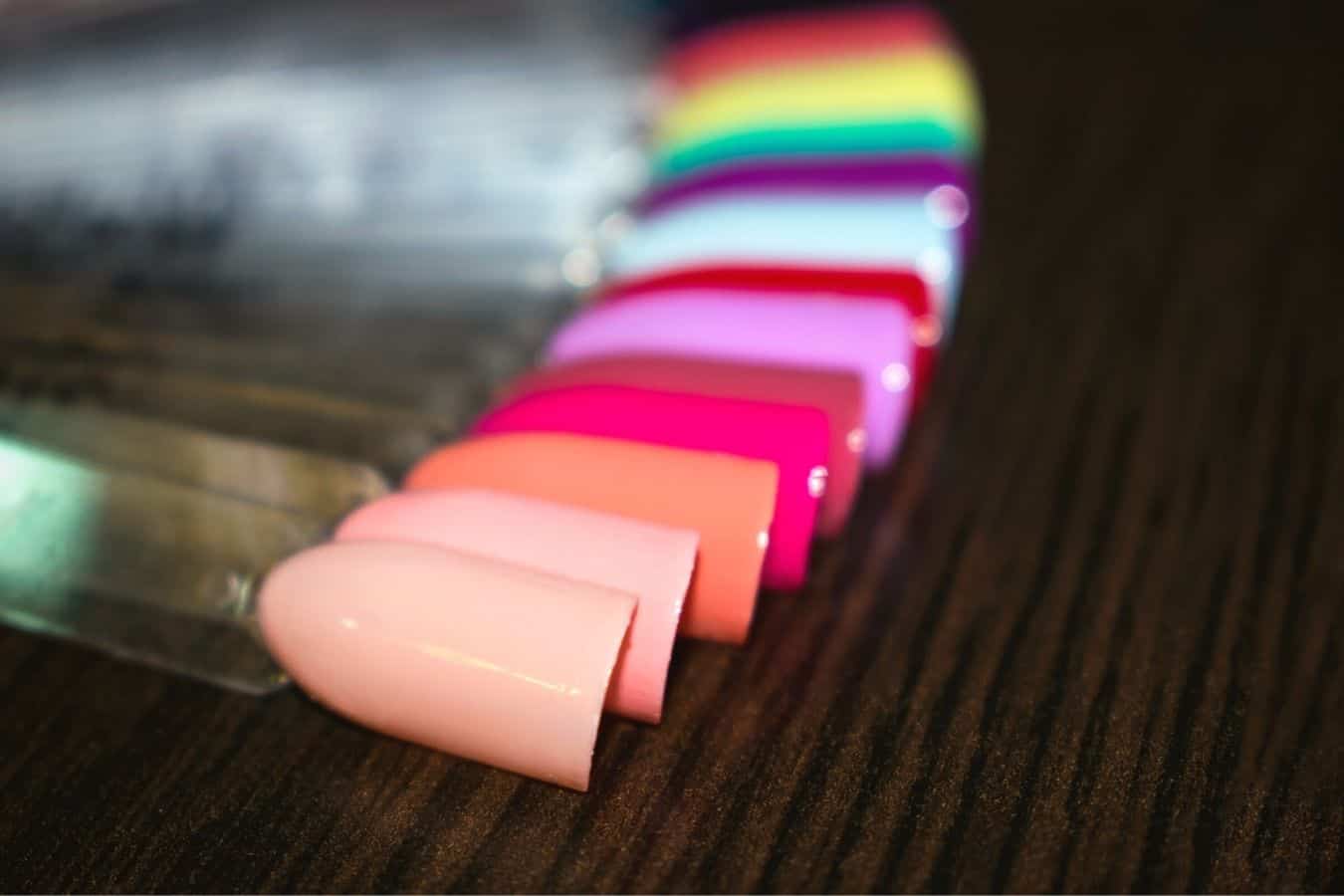Hair dye can stick to many different surfaces, including your acrylic nails. These stubborn stains can be hard to remove, but luckily, there are many successful methods you can try. Here’s how to get hair dye off acrylic nails.

The best ways to get hair dye off acrylic nails are:
- Using a Nail Brush
- Baby Oil
- Petroleum Jelly
- Using Hair Spray
- Alcohol Wipes
- Baking Soda Paste
- Whitening Toothpaste
- Painting Over Your Nails
- Remove Color With Acetone-free Nail Polish Remover
Check out each of the methods below.
Why Does Hair Dye Stain Acrylic Nails
Hair dye contains pigments and chemicals that work by depositing color and leaving a stain.
Some hair colors contain extra pigments or darker pigments that are more likely to leave a stain on not only your hands but also your bathroom tiles.
Black, purple and blue are the most common colors that leave stains because they are simply darker in color.
Acrylic nails are made by mixing a liquid acrylic with a powder acrylic product, which makes them more porous.
Hair dye can seep into the molecules of the plastic, leaving a stain that can be tough to remove.
How to Get Hair Dye Off Acrylic Nails

If you get hair dye on your acrylic nails and it doesn’t wash off straight away, then try not to panic. There are ways to remove the stain without damaging your nails.
1. Use A Nail Brush
The gentlest option would be to use soap, water, and a nail brush.
This works best on fresh stains before the dye has a chance to permanently stick to the surface.
Use a mild soap to wash your hands and nails with, then begin to gently rub them with a soft-bristle nail brush.
You should do this for a few minutes to see if the stain lifts. If it doesn’t lift, you can continue on to the next method.
2. Baby Oil
Baby oil might not be the most common method to remove hair dye stains, but it can work for some people, especially if the stain is fresh.
Rub a generous amount of baby oil onto the stained nails and let it sit there for a few hours. Many oils work by breaking down the pigments and baby oil is no exception.
After a few hours, rub your nails gently with a damp cloth to try and lift any hair dye residue. You can repeat this a few times to see if it makes any difference.
This method is safe and straightforward, but if it doesn’t work for you, move on to the next option.
Also Read: Does Hair Dye Expire? (Everything You Need To Know)
3. Petroleum Jelly
While petroleum jelly is often used as an emollient to soften and protect the skin, it can also be used as a gentler method to remove stains.
It’s not clear why this works, but it’s worth trying it before moving on to any of the other methods.
Apply a generous amount of the product to each nail and let it sit for a few minutes.
With a cotton pad or cloth, begin rubbing it with moderate pressure and see if the stain lifts.
This method is gentle so it can be repeated a few times. If nothing happens or the stain only lifts a little, you should try the next method.
4. Use Hair Spray
Hair spray is one of the best options to try first because it’s very effective at removing stubborn stains and most people will already have it in their cupboards.
It’s alcohol-based, which helps to break up the color and lift the stain from the nail. Simply spray some of the product onto the stained area and gently rub your nail with a soft cloth.
You can repeat this method twice if it doesn’t lift immediately, but be careful not to be too rough when rubbing as this can damage the nail.
5. Alcohol Wipes
Alternatively, if you’re looking for an easier and more convenient option, then alcohol wipes might be the answer.
Just like hair spray, the main ingredient is alcohol. This helps to break down the pigments and lift the stain.
Simply use one alcohol wipe to rub over each nail, applying medium pressure throughout.
Do this for at least a couple of minutes, before washing your hands with gentle soap and water. If your nails feel dry afterwards, apply a light cream to them.
Also Read: How To Remove Hair Dye With Developer
6. Baking Soda Paste
Baking soda is a common household item that works wonders on various types of stains, including hair dye.
To make the paste, you just need baking soda and water. Start with using 1/8th of a cup of baking soda and add a small amount of water at a time to create a thick paste.
Be careful not to add too much water, otherwise, it will be too runny to apply.
When you have a thick paste, begin applying it to the stains with your fingers, then use a soft cloth or sponge to gently rub against the nail.
Keep doing this until the stain begins to lift. If necessary, you can rinse your hands and repeat this method.
Sometimes, baking soda takes a couple of rinses before it starts to lift stubborn stains.
7. Whitening Toothpaste
While it’s not the most popular method for removing stains on nails, it has been proven to be effective for some people.
As whitening toothpaste is designed to lift surface stains from the teeth, it’s no surprise that it can be used to lift hair dye stains, too.
Regular toothpaste might not be effective, so opt for one that is designed to whiten smiles.
These toothpaste often contain baking soda and chemical whiteners that work by dissolving stains, revealing a cleaner and brighter surface.
Using a spare soft bristle toothbrush, apply a small amount to the brush and start gently rubbing it against the nails.
You can do this in gentle, circular motions as this has shown to be effective at lifting stains.
8. Paint Over Your Nails
If nothing else works, you might want to consider painting over your nails. To do this, you need to follow certain steps to avoid damaging the acrylic nails.
9. Remove Color With Acetone-free Nail Polish Remover
Regular nail varnish remover can cause the acrylic nails to come off, so you should choose one that doesn’t contain acetone.
Pour a small amount of the nail polish remover on a cotton pad and start gently rubbing at the nails. Keep doing this until all of the color comes off, then wash your hands with a mild soap.
Wait for your fingernails to dry completely before moving on to the next step:
Apply A Base Coat
Applying a base coat before the polish is a necessary step that can make the nail polish glide on more smoothly and create a nice, even finish.
It also helps to prolong the lifespan of the nails, too. Apply one or two coats, depending on your preferences.
Wait for the base coat to dry completely before applying the polish. You can check by gently touching the nail and observing if it feels tacky.
If you’re unsure, it’s always best to wait a few minutes.
Apply Nail Polish
Choose your desired nail polish and apply one coat to each nail. After you’ve applied the first coat, wait until the nails are thoroughly dry before applying the next.
You might have to wait 20 minutes or more, depending on the polish. For this reason, it’s best to look for quick drying polishes. Apply one or two more coats, if needed.
Apply A Top Coat
The final step requires you to apply a top coat to seal everything in and protect the color from chipping.
Always ensure the nails are fully dry before finishing with the top coat. One single coat of top coat should be enough, but you can apply an extra coat if needed.
See A Nail Technician
Not everyone will feel comfortable with painting their own acrylic nails, so it might be best to leave it to the professionals.
If you can’t lift the stains, arrange an appointment with your nail technician to see if there is anything they can recommend.
They could suggest replacing the acrylic nails or painting over them, but at least you will be in safe hands.
Also Read: How To Get Hair Dye Off Skin (8 Methods That Work!)
What Other Things Can Stain Acrylics?
As acrylic nails are porous, they are more likely to absorb dyes and anything containing dark or intense pigments, such as tobacco, red wine, turmeric, and polish.
Many of these contain naturally occurring pigments that are often hard to remove.
If you use these products regularly, you should remember to wear gloves or wash your hands immediately after handling them.
If you act quickly, it’s less likely to leave a permanent stain.
How To Prevent Hair Dye From Staining Your Acrylics

The easiest and most effective way to prevent hair dye from staining your acrylic nails is to wear gloves.
You should put gloves on from the beginning to the end of the hair dyeing process, including when you rinse the dye out.
This will usually ensure that your nails are protected against stains. There are certain occasions when hair dye can seep through the gloves and still stain the hands and nails.
Another great way to prevent hair dye stains is to apply petroleum jelly to the surface of the nails and the cuticles.
You can use this in combination with the gloves to act as a double barrier. Petroleum jelly is greasy and creates enough slip to prevent stains.
Instead of the dye staining the nails, it will simply stain the surface instead. After you’ve used the dye, you can simply wipe the surface of your nails and they should remain untouched.
If you regularly dye your hair or you often come into contact with products with high-staining properties, you might want to consider opting for dark-colored acrylics instead.
Stains are less likely to show up on darker nails, so it works as a preventative measure.
Disclaimer: This site is not intended to provide professional or medical advice. All of the content on LovedByCurls.com is for informational purposes only. All advice should be followed at your own discretion. Ingredients may change at any time so always check the product label before using. Check our full disclaimer policy here.
